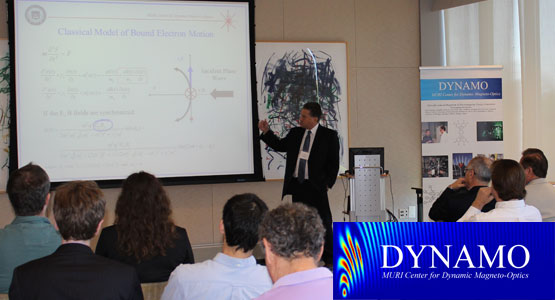New research program to investigate optical energy conversion
The fundamental objective of the research initiative is to uncover, explain, and exploit dynamic magneto-optical processes and materials for new technological capabilities.

 Enlarge
Enlarge
Michigan is home to a new major research program that aims to provide a better understanding of phenomena driven by the magnetic field component of light. A key long-term goal of this five-year, $7.5M Multi-University Research Initiative (MURI), called the Center for Dynamic Magneto-Optics (DYNAMO), is to investigate the prospects for direct conversion of light to electricity without the thermodynamic losses typical of photovoltaic (solar cell) technology.
Prof. Stephen Rand, PI of the project, stated that, “the fundamental objective of this basic research initiative is to uncover, explain, and exploit dynamic magneto-optical processes and materials for new technological capabilities. A particularly important process is the magneto-electric conversion (MEC) process, that in principle accomplishes the highly-efficient transformation of light energy into electricity without generating much heat in transparent insulating materials.”
“What we are potentially talking about here is using light to charge capacitors – which are energy storing devices – simply by passing the light through a material to create a charge separation that can then work in the outside world, said Rand. “MEC should enable direct conversion of any kind of intense light into electricity, whether the input is in the form of sunlight, laser beams, or other forms of directed energy, because coherence of the input light is not required.”
In foundational research that led to the current project, Prof. Rand came to the rather startling discovery in 2007 that, under the right conditions, a low-intensity light field can generate magnetic effects that are one million times stronger than previously expected. Under these circumstances, the magnetic effects develop strength equivalent to a strong electric effect.
“This could lead to a new kind of solar cell without semiconductors and without absorption to produce charge separation,” Rand said. [see press release]
The Center will establish the framework required to develop a new and revolutionary class of materials capable of sustained operation of magneto-electric conversion. The three primary objectives of the Center are:
- (1) to gain an improved understanding of the mechanism of new nonlinear optical effects,
- (2) to investigate their response to coherent and incoherent radiation, and
- (3) to guide transformative scientific advances in optical energy conversion.
The University of Michigan is lead institution in this effort, and is partnering with Northwestern University, Columbia University, and the University of Central Florida, as well as international collaborators.
At Michigan, Prof. Rand will lead the Optical Magentism research thrust, and Dr. John Whitakerwill lead the Charge Separation Effects research thrust. Anthony Bloch, Alexander Ziwet Collegiate Professor of Mathematics, and Fred Adams, Collegiate Professor of Physics, will investigate the sensitivity of these new effects to noise. Prof. Jinsang Kim and Prof. Richard Lainein the Dept. of Materials Science and Engineering will synthesize polymeric materials that may support magneto-electric processes at reduced intensities. Physics professor Franco Nori will seek to improve our understanding of what processes, and what geometries, link non-relativistic and relativistic magneto-electric effects.
Tony Heinz, David M. Rickey Professor of Physics and Electrical Engineering at Columbia University, will lead the Harmonic Generation & Relativity research thrust. At Northwestern University, Tobin Marks, Charles E. and Emma H. Morrison Professor of Chemistry, and Mark Ratner, Lawrence B. Dumas Distinguished University Professor, will anchor the investigation of new materials to optimize magneto-electric response by heading up the synthesis effort of inorganic crystals, ceramics, and complex material design.
Their kickoff meeting was held May 23, 2014 at the University of Michigan.

 MENU
MENU 
